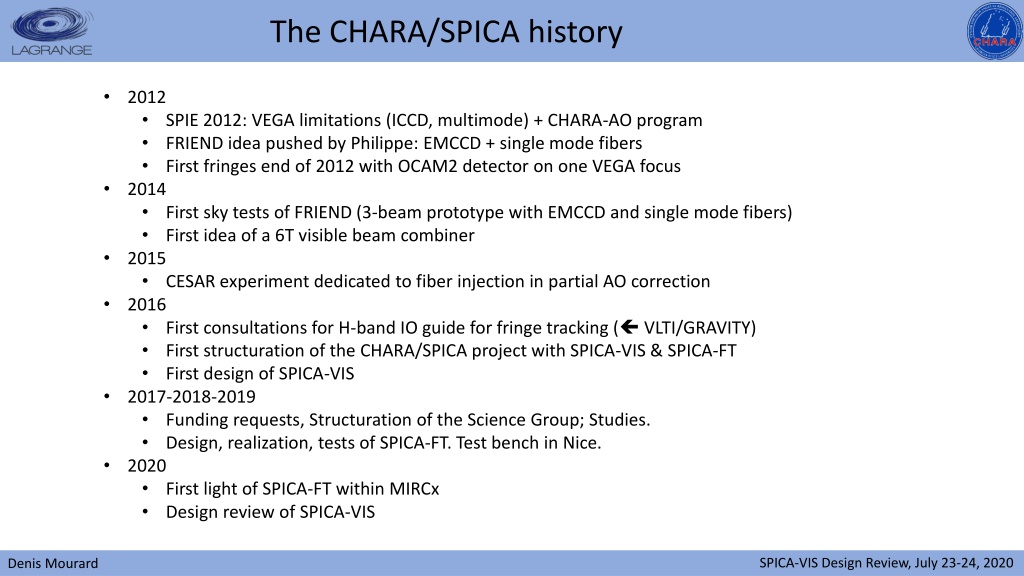Development of CHARA/SPICA Project for Stellar Astrophysics Research
CHARA/SPICA project history spans from funding requests to the realization of SPICA instruments, including SPICA-FT and SPICA-VIS. Scientific requirements focus on stellar physics, visible interferometry, and large surveys for stellar parameters determination, with detailed specifications for fringe sensors, visible instruments, and limb darkening measurements. The project aims to contribute to advancements in astrophysics through precision measurements and imaging capabilities.
- CHARA/SPICA project
- Stellar astrophysics
- Interferometry
- Scientific requirements
- Astronomical instrumentation
Download Presentation

Please find below an Image/Link to download the presentation.
The content on the website is provided AS IS for your information and personal use only. It may not be sold, licensed, or shared on other websites without obtaining consent from the author. Download presentation by click this link. If you encounter any issues during the download, it is possible that the publisher has removed the file from their server.
E N D
Presentation Transcript
The CHARA/SPICA history 2012 2014 2015 2016 2017-2018-2019 Funding requests, Structuration of the Science Group; Studies. Design, realization, tests of SPICA-FT. Test bench in Nice. 2020 First light of SPICA-FT within MIRCx Design review of SPICA-VIS SPIE 2012: VEGA limitations (ICCD, multimode) + CHARA-AO program FRIEND idea pushed by Philippe: EMCCD + single mode fibers First fringes end of 2012 with OCAM2 detector on one VEGA focus First sky tests of FRIEND (3-beam prototype with EMCCD and single mode fibers) First idea of a 6T visible beam combiner CESAR experiment dedicated to fiber injection in partial AO correction First consultations for H-band IO guide for fringe tracking ( VLTI/GRAVITY) First structuration of the CHARA/SPICA project with SPICA-VIS & SPICA-FT First design of SPICA-VIS SPICA-VIS Design Review, July 23-24, 2020 Denis Mourard
Scientific Requirements - general considerations General astrophysical framework during the development of SPICA Sun as a star Star-Planet relations Renewal of stellar physics through asteroseismology, photometric transits, distance measurements Unique niche for CHARA visible with 0.1mas angular resolution Core program Fundamental parameters: R & Teff, through LD and + Fbol Surface-brightness color relations for estimation of angular diameters ( extragalactic distances) Stellar activity (rotation, multiplicity, environment ) as stellar noise for exoplanet science Extension of the program through the Visible Interferometry Science Cases whitebook (Stee et al., 2015, ArXiv) General idea around the development of CHARA/SPICA Design dedicated to large (~1000 *) surveys: automation Sensitivity R=8 for a good coverage of the HR diagram AO + LR Precision R/R=1% Spatial filtering, photometric channels Efficiency 15 baselines, large number of spectral channels MR/HR for stellar activity, imaging capability Strong link with the ESA/PLATO Mission (but also TESS, CHEOPS, ARIEL) CHARA/SPICA products included in the non- seismic stellar parameters determination. Considered as follow-up facility (TBC) SPICA-VIS Design Review, July 23-24, 2020 Denis Mourard
Scientific Requirements: specifications 1. A H-band 6T-ABCD fringe sensor aiming at performing a group delay and phase delay tracking of the fringes. 2. A visible instrument combining All-In-One the 6 CHARA beams in the optical domain (600-850nm) and proposing two main modes of dispersion: R=140 for sensitivity and angular diameter measurements Spectral band 600-850nm; 50 spectral channels of ~5nm for stars with theta=0.2mas, V >0.6 for stars with theta=0.5mas, V >0.02 for limb darkening (>0.8mas) V min=0.002 R=3000 for spectral imaging Spectral band of ~65nm in 600-850nm; 250 spectral channels of ~0.25nm Differential visibility measurements V =0.6 or V =0.1 R=10000 for specific programs SNR on V for one spectral channel: V =0.02, 10mn, R=140 DIT = 20ms, 200ms, 10s Development of a SNR model for V and Vdiff, based on the FRIEND paper. Noise model in ASPRO2 for more detailed simulations SPICA-VIS Design Review, July 23-24, 2020 Denis Mourard
Scientific Requirements: LD and (LD+LD) measurements LDonly with hypothesis on the LD law R/R=1% LDand LD from SPICA SPICA-VIS Design Review, July 23-24, 2020 Denis Mourard
Scientific Requirements: definition of the large survey SPICA-VIS Design Review, July 23-24, 2020 Denis Mourard
Scientific Requirements: conclusion WP1 R. LIGI - Exoplanet Host Stars (Survey: 60D+5I = 65*) for analysis of fundamental parameters of stars and planets WP2 S. DEHEUVELS - known asteroseismic targets F5 to K7 dwarfs (Survey: 185D+16I = 200*) for analysis of fundamental parameters of stars + inputs for SBCR (WP7) WP3 O. CREEVEY - known asteroseismic targets F5 to K7 giants (and sub-giants) (Survey: 92D+8I = 100*) for analysis of fundamental parameters of stars + inputs for SBCR (WP7) WP4 N. NARDETTO - B4-F5 asteroseismic/pulsating stars (Survey: 252D+22I = 275*) for analysis of fundamental parameters of stars WP5 T. BOYAJIAN - K7 to M dwarfs (Survey: 64D+3I = 67*) for analysis of fundamental parameters of stars WP6 D. GRACZYK - O, B1, B2, B3 (Survey: 83D+7I = 90*) for analysis of fundamental parameters of stars + inputs for SBCR (WP7) + input for study of stellar activity (WP8, 9, 12) + input for LD (WP11) WP7 N. NARDETTO - SBCR Analysis: WP to be connected to WP1, 2, 3, 5 and 6 WP11 A. CLARET + D. MOURARD - Limb-darkening across the HR diagram WP8 D. MOURARD + G. SCHAEFER - Binaries: (Survey: 60I) for analysis of mass in HR diagram. WP9 A. DOMICIANO - Rotation: (Survey: 60I) for analysis of the rotation of stars in HR diagram. WP12 M. WITTKOWSKI - Winds & Environment (Survey: 64D+4I = 68* or 15I) for analysis of the wind and environment of stars in HR diagram. WP10 S. KRAUS - YSOs: Additional program with 15I. WP13 C. SOUBIRAN - Galactic Archeology (tbd) SPICA-VIS Design Review, July 23-24, 2020 Denis Mourard


![[PDF⚡READ❤ONLINE] Black Hole Astrophysics: The Engine Paradigm (Springer Praxis](/thumb/21503/pdf-read-online-black-hole-astrophysics-the-engine-paradigm-springer-praxis.jpg)
![[PDF⚡READ❤ONLINE] Cosmology and Particle Astrophysics (Wiley-Praxis Series in As](/thumb/21627/pdf-read-online-cosmology-and-particle-astrophysics-wiley-praxis-series-in-as.jpg)



















